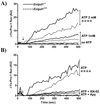NTPDase1 governs P2X7-dependent functions in murine macrophages
- PMID: 20201036
- PMCID: PMC3045779
- DOI: 10.1002/eji.200939741
NTPDase1 governs P2X7-dependent functions in murine macrophages
Abstract
P2X7 receptor is an adenosine triphosphate (ATP)-gated ion channel within the multiprotein inflammasome complex. Until now, little is known about regulation of P2X7 effector functions in macrophages. In this study, we show that nucleoside triphosphate diphosphohydrolase 1 (NTPDase1)/CD39 is the dominant ectonucleotidase expressed by murine peritoneal macrophages and that it regulates P2X7-dependent responses in these cells. Macrophages isolated from NTPDase1-null mice (Entpd1(-/-)) were devoid of all ADPase and most ATPase activities when compared with WT macrophages (Entpd1(+/+)). Entpd1(-/-) macrophages exposed to millimolar concentrations of ATP were more susceptible to cell death, released more IL-1beta and IL-18 after TLR2 or TLR4 priming, and incorporated the fluorescent dye Yo-Pro-1 more efficiently (suggestive of increased pore formation) than Entpd1(+/+) cells. Consistent with these observations, NTPDase1 regulated P2X7-associated IL-1beta release after synthesis, and this process occurred independently of, and prior to, cytokine maturation by caspase-1. NTPDase1 also inhibited IL-1beta release in vivo in the air pouch inflammatory model. Exudates of LPS-injected Entpd1(-/-) mice had significantly higher IL-1beta levels when compared with Entpd1(+/+) mice. Altogether, our studies suggest that NTPDase1/CD39 plays a key role in the control of P2X7-dependent macrophage responses.
Conflict of interest statement
The authors declare no financial or commercial conflict of interest.
Figures







Similar articles
-
CD39 limits P2X7 receptor inflammatory signaling and attenuates sepsis-induced liver injury.J Hepatol. 2017 Oct;67(4):716-726. doi: 10.1016/j.jhep.2017.05.021. Epub 2017 May 26. J Hepatol. 2017. PMID: 28554875 Free PMC article.
-
TLR agonists stimulate Nlrp3-dependent IL-1β production independently of the purinergic P2X7 receptor in dendritic cells and in vivo.J Immunol. 2013 Jan 1;190(1):334-9. doi: 10.4049/jimmunol.1202737. Epub 2012 Dec 7. J Immunol. 2013. PMID: 23225887 Free PMC article.
-
Targeted deletion of ectonucleoside triphosphate diphosphohydrolase 1/CD39 leads to desensitization of pre- and postsynaptic purinergic P2 receptors.J Pharmacol Exp Ther. 2007 Sep;322(3):1269-77. doi: 10.1124/jpet.107.125328. Epub 2007 Jun 12. J Pharmacol Exp Ther. 2007. PMID: 17565006
-
P2X7 Receptor at the Crossroads of T Cell Fate.Int J Mol Sci. 2020 Jul 13;21(14):4937. doi: 10.3390/ijms21144937. Int J Mol Sci. 2020. PMID: 32668623 Free PMC article. Review.
-
Ectonucleotidases of CD39 family modulate vascular inflammation and thrombosis in transplantation.Semin Thromb Hemost. 2005 Apr;31(2):217-33. doi: 10.1055/s-2005-869527. Semin Thromb Hemost. 2005. PMID: 15852225 Review.
Cited by
-
Adenosine metabolism, immunity and joint health.Biochem Pharmacol. 2018 May;151:307-313. doi: 10.1016/j.bcp.2018.02.002. Epub 2018 Feb 7. Biochem Pharmacol. 2018. PMID: 29427624 Free PMC article. Review.
-
CD39: Interface between vascular thrombosis and inflammation.Curr Atheroscler Rep. 2014 Jul;16(7):425. doi: 10.1007/s11883-014-0425-1. Curr Atheroscler Rep. 2014. PMID: 24838375 Free PMC article. Review.
-
Loss of vascular expression of nucleoside triphosphate diphosphohydrolase-1/CD39 in hypertension.Purinergic Signal. 2018 Mar;14(1):73-82. doi: 10.1007/s11302-017-9597-9. Epub 2017 Dec 13. Purinergic Signal. 2018. PMID: 29236227 Free PMC article.
-
The P2X7 receptor modulates immune cells infiltration, ectonucleotidases expression and extracellular ATP levels in the tumor microenvironment.Oncogene. 2019 May;38(19):3636-3650. doi: 10.1038/s41388-019-0684-y. Epub 2019 Jan 17. Oncogene. 2019. PMID: 30655604 Free PMC article.
-
P2X7 integrates PI3K/AKT and AMPK-PRAS40-mTOR signaling pathways to mediate tumor cell death.PLoS One. 2013;8(4):e60184. doi: 10.1371/journal.pone.0060184. Epub 2013 Apr 2. PLoS One. 2013. PMID: 23565201 Free PMC article.
References
-
- Dinarello CA. The IL-1 family and inflammatory diseases. Clin Exp Rheumatol. 2002;20:S1–S13. - PubMed
-
- Pelegrin P. Targeting Interleukin-1 Signaling in Chronic Inflammation: Focus on P2X7 Receptor and Pannexin-1. Drug News Perspect. 2008;21:424–433. - PubMed
-
- Di Virgilio F. Liaisons dangereuses: P2X(7) and the inflammasome. Trends Pharmacol Sci. 2007;28:465–472. - PubMed
-
- Bours MJ, Swennen EL, Di Virgilio F, Cronstein BN, Dagnelie PC. Adenosine 5'-triphosphate and adenosine as endogenous signaling molecules in immunity and inflammation. Pharmacol Ther. 2006;112:358–404. - PubMed
Publication types
MeSH terms
Substances
Grants and funding
LinkOut - more resources
Full Text Sources
Molecular Biology Databases
Research Materials
Miscellaneous

